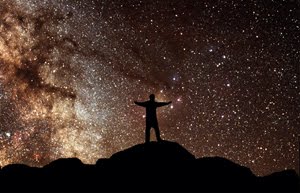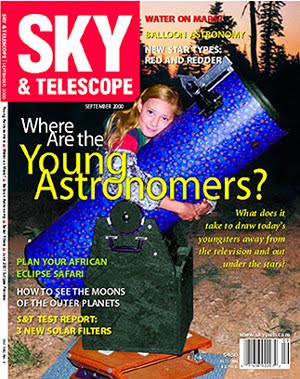Yes, the name is relevant. But first, I am tired, writing this at 9 p.m Sunday night, so, sorry for any errors...
This weekend was only my second 2-niter observing this year, not counting the summer trip to Mount Lassen. I arrived at Fremont Peak about 7:15 Friday evening, finding Ken Head, John Hales and Michelle Stone waiting. Soon, Rich Neuschaefer, Rod Norden and Bill Arnett showed, and a new observer names Steve (sorry I forgot your last name if you're reading). Apologies, if I left anyone out.
The sky looked good and the fog layer thick, as the sun dropped and the earth's shadow rose. Our equipment was set up and the I was naturally drawn to a piece of equipment next to Steve's car. Wow! 120mm binoculars, off a Japanese World War II naval vessel. These babies were the beefiest binos I have ever seen. Unmounted, Steve told me, they weighed 46 lbs. These binocs performed beautifully on the Double Cluster in Perseus, and M31 in Andromeda. In fact, with the 3 degree field of the binos, it was easy to pick out M32 and M110 around the main galaxy.
Rod, Rich and Bill were the planetary representatives for the evening, John and Michelle were playing with an ST4, practicing autoguiding, Steve was doing some photos via his 10" LX-200, and I was, well, as usual, bringing up the rear with the faint stuff.
The sky was not very good, as bands of long thin clouds cycled through all night. However, there were opportunities to view in through large open spaces between the cloud bands. I worked Cassiopia, finishing off the Hershel objects (open clusters) in the constellation, then on to Andromeda, Draco and Cetus. All prime Hershel territory, lots of galaxies.
I was using the old 14.5" dob made by Crazy Ed (one of our list members), and stayed almost exclusively with the 19 Panoptic, yielding 107X. It seems the perfect eyepiece for finding faint objects, and still, giving some hints if there is detail in the target. Occasionally I would drop in a 10.5mm or 7.5mm, but only when looking at Jupiter, Saturn or Uranus.
Speaking of Saturn, the view through the 7" Astrophysics was absolutely spectacular. The detail in the rings, the subtle shading on the disc, the moons, all provided more enjoyment than I had time for. Oh, to have such a scope and be able to sit at that eyepiece for hours rather than having to settle for shared views. Our group is fortunate to have several high quality refractor owners (yes, the owners and their equipment are all high quality!).
During the night, a few highlights were view of M33, with outrageous mottling, dark blotches and bright HII regions, and later, NGC253, which looked like a photo, filling the field of view. If any of you have not viewed 253 before, put it on your list, it is a buster of a galaxy, and this is the time of year for it.
I was tired and had hit a number of Hershel objects, so, decided to call it a night. Rich, Steve, Michelle and Bill were still going strong, but Hales and I need our rest. From somewhere in my semiconsciousness, I heard Arnett leave, and then as the others turned in, the peak was nothing more than a symphony of crickets.
Now for the four wheelin' part of the tale. The person involved is the owner of a 180mm f/9 EDT AstroPhysics APO refractor. Had put his tube assembly away in the back of his Toyota truck, and stretched himself out in the cab of the vehicle with his feet across the cab toward the passenger door. He was parked next to me, both our vehicles facing the top of the road that enters the southwest parking lot. We were headed downhill.
Before any more details are provided, the owner is safe and well at home tonight, and the lesson is to always check your parking brake and turn your wheels uphill.
I awoke to the strange sound of tires rolling. I sat up on my cot and witnessed the Toyota slowly rolling away from the pier assembly that had held the 180 APO. "What's he doing" I thought, in a state of confusion. Why is he leaving without starting his engine, and leaving the pier. Suddenly, as the truck picked up steam in its downhill roll, I realized the occupant must be asleep. I jumped up and yelled "HEY .... WAKE UP!" but the vehicle by them had attained perhaps 20mph and was crashing through the flimsy guard railing along the top of the road, and, with frightening suddenness, plunged from sight down the mountainside.
Oh my God! I ran toward the other sleepers yelling to get up, that a car was going down the mountain. At that time several "WHUMP.... BUMP... BUMPs" could be heard down the mountain. The truck had crashed and now it was quiet.
I turned and ran, through the missing guard rail and down the hillside, finding my way by starlight. Very soon, Steve was behind me (this guy is quick, but I guess his military conditioning helped... I was on a massive adrenaline rush). Steve shone his mag-light down the ravine and there, wobbling up toward me, I saw a red sweatshirt...
"You all right?" I yelled. "Uh, well.... I think so" came the reply. We got back down to the truck quickly. It was turned sideways and leaning 30 degrees. The passenger quickly said, in true refractor owner fashion... "I hope the telescope's okay". "The telecope?" I said. I was incredulous. The guy was lucky to be alive, or at least not seriously injured, and he was worried about the scope!
He wanted to drive the truck back uphill right away, but I suggested we wait until daytime to see what we were facing. We all hiked back up, dodging poison oak and only then realizing just how far the truck had traveled down the canyon.
It took several hours to calm down. That sort of excitement and exertion is an astonishing combination. In the morning light we would see the truck had traveled at least 100 yard beyond the fence, the first 20 yards being a good grade but gentle, the last 80 or more being steep enough to make walking somewhat challenging at times. Near the bottom of "Mr. Toad's Wild Ride" was an old roadbed traversing the hill. At that point, the tire tracks from the truck stopped, replaced by a large divit. Landing spot was about 20 feet beyond. The occupant had been thrown from the cab of the truck during the airborne portion of the ride.
The truck owner was not seriously hurt (a few bumps and bruises). The truck was not damaged. The scopes was unfazed. The two bottles of wine were not broken. The truck went into 4-wheel-drive and I found myself chasing it up the hill.
All was well with the world.
You might wonder what the occupant of such a mishap might think during the ride. Since there was a tarp over the windshield (to block the morning sunlight), the rider could not see. He was also disoriented when the first bumping woke him. He thought we were having an earthquake. Once beyond the gentle slope, he thought we were having a big earthquake. When he hit the launching ramp near the bottom, he thought "This is THE BIG ONE!!!" and the damage must be incredible.
At that point he realized what was happening, and he became separated from the airborne vehicle.
We didn't get any sleep after that experience.
The day passed uneventfully, other than an enjoyable ride in my now out-of-mothballs Datsun 280ZX ride down to the market in San Juan Bautista for food and drink. Back up at the observing site, we sat and yacked, drank, ate and relaxed. I still could not sleep. I knew I'd be tired that night.
At 2:30, Alan Nelms drove in. Then, we sat and wondered where everyone was on such a clear and warm day...
By dark, we had 21 telescopes and owners set up in the lot. Here is a rundown on the great variety of equipment present:
8" f/6 Newtonian, 10" LX-200, 14.5" f/5.2 dob, 10" LX-200, 8" Meade equatorial Newtonian, Celestron 8" Ultima 2000, 9.25" f/5 equatorially mounted newt, 5.25" f/5 equatorially mounted Newtonian,8" Celestron SCT on a G-11 mount and Pronto piggy-back, JMI NGT-18, 225mm f/12 Takahashi SCT, 11" f/4.5 dob (from SJAA loaner program), 8" Meade SCT (a good one!), 18" f/4.5 Obsession, 14.5" f/5.6 dob, 180mm f/9 EDT AstroPhysics APO refractor on an AP 800 mount, 16" f/5 dob, 100mm f/10 Zeiss refractor, 8" f/6 dob, 8" LX-200 and a 6" Intes Maksutov.
If you want to check out equipment, these star parties are a great place to do it!
Dinner time came. Hales and I opened our canned dinners and enjoyed the gourmet fare together. A little wine to wash it down, toasting the owner of the stunt vehicle with some of the surviving vino.
The fog cover, which had completely surrounded the peak on Friday night, was missing. This would be a brighter night. Bands of clouds once again began appearing. I walked among the valley of the dobs for a while, enjoying the site of so many people in one place, sharing their enjoyment and knowledge. Alan and I began working the Hershel list again.
Things were back to normal... except that I'd had no sleep.
By midnight, lack of sleep was hitting me hard. I was beginning to wobble. Soon, I was sitting. After a few minutes I climbed into the sleeping bag on my cot, laid back and watched the sky become much needed sleep.
I never thought an observing trip could be such an adventure.











